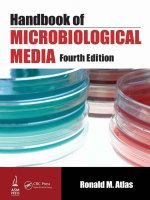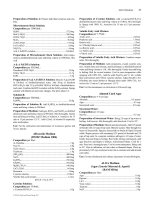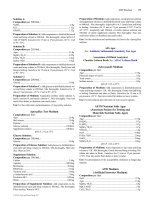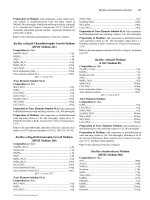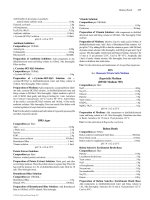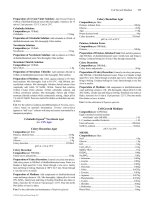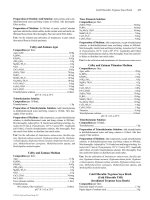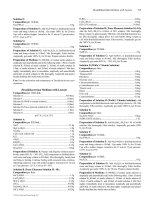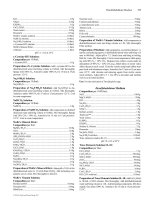Handbook of Microbiological Media, Fourth Edition part 45 ppt
Bạn đang xem bản rút gọn của tài liệu. Xem và tải ngay bản đầy đủ của tài liệu tại đây (217.74 KB, 10 trang )
Cold Filterable Tryptone Soya Broth 435
Preparation of Oxolinic Acid Solution: Add oxolinic acid to dis-
tilled/deionized water and bring volume to 10.0mL. Mix thoroughly.
Filter sterilize.
Preparation of Medium: To 930.0mL of sterile, cooled Columbia
agar base, add sterile colistin sulfate, sterile oxolinic acid, and sterile, de-
fibrinated horse blood. Mix thoroughly. Pour into sterile Petri dishes.
Use: For the isolation and cultivation of streptococci in pure culture
from mixed flora in clinical specimens.
Colby and Zatman Agar
Composition per liter:
Agar, noble 20.0g
K
2
HPO
4
1.2g
KH
2
PO
4
0.62g
(NH
4
)
2
SO
4
0.5g
MgSO
4
·7H
2
O 0.2g
NaCl 0.1g
CaCl
2
·6H
2
O 0.05g
ZnSO
4
·7H
2
O 70.0μg
H
3
BO
3
10.0μg
MnSO
4
·5H
2
O 10.0μg
Na
2
MoO
4
·2H
2
O 10.0μg
CoCl
2
·6H
2
O 5.0μg
CuSO
4
·5H
2
O 5.0μg
FeCl
3
·6H
2
O 1.0mg
Trimethylamine solution 10.0mL
pH 7.0 ± 0.2 at 25°C
Trimethylamine Solution
Composition
per 10.0mL:
Trimethylamine 1.0g
Preparation of Trimethylamine Solution: Add trimethylamine
to distilled/deionized water and bring volume to 10.0mL. Mix thor-
oughly. Filter sterilize.
Preparation of Medium: Add components, except trimethylamine
solution, to distilled/deionized water and bring volume to 990.0mL.
Mix thoroughly. Adjust pH to 7.0. Gently heat and bring to boiling. Au-
toclave for 15 min at 15 psi pressure–121°C. Cool to 50°C. Aseptically
add 10.0mL of sterile trimethylamine solution. Mix thoroughly. Pour
into sterile Petri dishes or distribute into sterile tubes.
Use: For the cultivation of Aminobacter aminovorans, Bacillus spe-
cies, Hyphomicrobium aestuarii, Hyphomicrobium facilis, Hyphomi-
crobium species, Hyphomicrobium variabile, Hyphomicrobium zavar-
zinii, Methylobacterium extorquens, Methylobacterium species, and
Methylophilus methylotrophus.
Colby and Zatman Medium
Composition per liter:
Agar 15.0g
K
2
HPO
4
1.2g
KH
2
PO
4
0.62g
(NH
4
)
2
SO
4
0.5g
MgSO
4
·7H
2
O 0.2g
NaCl 0.1g
CaCl
2
·2H
2
O 34.0mg
FeCl
3
·H
2
O 1.0mg
Trace elements solution 1.0mL
Trimethylamine,
10% solution, filter sterilized 10.0mL
pH 7.0 ± 0.2 at 25°C
Trace Elements Solution:
Composition
per liter:
ZnSO
4
·7H
2
O 70.0mg
H
3
BO
3
10.0mg
Na
2
MoO
4
·2H
2
O 10.0mg
MnSO
4
·H
2
O 7.0mg
CoCl
2
·H
2
O 5.0mg
CuSO
4
·5H
2
O 5.0mg
Preparation of Medium: Add components, except trimethylamine
solution, to distilled/deionized water and bring volume to 990.0mL.
Mix thoroughly. Gently heat and bring to boiling. Autoclave for 15 min
at 15 psi pressure–121°C. Cool to 50°–55°C. Aseptically add 10.0mL
of sterile trimethylamine solution. Mix thoroughly. Pour into sterile Pe-
tri dishes or distribute into sterile tubes.
Use: For the cultivation and maintenance of Aminomonas aminovorus.
Colby and Zatman Thiamine Medium
Composition per liter:
Agar, noble 20.0g
K
2
HPO
4
1.2g
KH
2
PO
4
0.62g
(NH
4
)
2
·SO
4
0.5g
MgSO
4
·7H
2
O 0.2g
NaCl 0.1g
CaCl
2
·6H
2
O 0.05g
FeCl
3
·6H
2
O 1.0mg
ZnSO
4
·7H
2
O 70.0μg
H
3
BO
3
10.0μg
MnSO
4
·5H
2
O 10.0μg
Na
2
MoO
4
·2H
2
O 10.0μg
CoCl
2
·6H
2
O 5.0μg
CuSO
4
·5H
2
O 5.0μg
Thiamine 0.5mg
Trimethylamine solution 10.0mL
pH 7.0 ± 0.2 at 25°C
Trimethylamine Solution
Composition
per 10.0mL:
Trimethylamine 1.0g
Preparation of Trimethylamine Solution: Add trimethylamine
to distilled/deionized water and bring volume to 10.0mL. Mix thor-
oughly. Filter sterilize.
Preparation of Medium: Add components, except trimethylamine
solution, to distilled/deionized water and bring volume to 990.0mL.
Mix thoroughly. Adjust pH to 7.0. Gently heat and bring to boiling. Au-
toclave for 15 min at 15 psi pressure–121°C. Cool to 50°C. Aseptically
add 10.0mL of sterile trimethylamine solution. Mix thoroughly. Pour
into sterile Petri dishes or distribute into sterile tubes.
Use: For the cultivation of Aminobacter aminovorans, Bacillus spe-
cies, Hyphomicrobium aestuarii, Hyphomicrobium facilis, Hyphomi-
crobium species, Hyphomicrobium variabile, Hyphomicrobium zavar-
zinii, Methylobacterium extorquens, Methylobacterium species, and
Methylophilus methylotrophus.
Cold Filterable Tryptone Soya Broth
(Cold Filterable TSB)
(Irradiated Tryptone Soya Broth)
Composition per liter:
Pancreatic digest of casein 17.0g
Papaic digest of soybean meal 3.0g
© 2010 by Taylor and Francis Group, LLC
436 Cold Filterable Vegetable Peptone Broth
NaCl 5.0g
K
2
HPO
4
2.5g
Glucose 2.5g
pH 7.3± 0.2 at 25°C
Source: This medium is available from Oxoid Unipath.
Preparation of Medium: Ready to use as a sterile gamma irradiat-
ed solution.
Use: For the cultivation of a wide variety of microorganisms. For
microbiological Media Fill Trials (MFT) for the pharmaceutical indus-
try.
Cold Filterable Vegetable Peptone Broth
(cfVPB)
Composition per liter:
Vegetable peptone 18.0g
NaCl 5.0g
Yeast extract 3.0g
Glucose 2.5g
K
2
HPO
4
2.5g
pH 7.0 ± 0.2 at 25°C
Source: Available in polyethene bags from Oxoid Unipath.
Preparation of Medium: Ready to use as a sterile gamma irradiat-
ed solution.
Use: For use in process simulations in the pharmaceutical industry,
either as a liquid placebo, or as a growth medium for a solid placebo,
added downstream of processing.
Coletsos Medium
Composition per 1625mL:
Potato starch 10.0g
Gelatin 4.0g
Asparagine 2.25g
KH
2
PO
4
1.5g
Na-glutamate 1.0g
Na-pyruvate 1.0g
Mg-citrate 0.375g
Litmus 0.25g
Malachite green 0.25g
MgSO
4
0.15g
Activated carbon 0.1g
Oligonucleotide mixture 3.0mg
Egg mixture 625.0mL
Glycerol 7.5mL
Egg Mixture:
Composition
per liter:
Whole eggs 18–24
Preparation of Egg Mixture: Use fresh eggs, less than 1 week old.
Scrub the shells with soap. Let stand in a soap solution for 30 min.
Rinse in running water. Soak eggs in 70% ethanol for 15 min. Break
the eggs into a sterile container. Separate egg whites from egg yolks.
Combine 8 parts egg white with 2 parts egg yolk. Homogenize by shak-
ing. Filter through four layers of sterile cheesecloth into a sterile grad-
uated cylinder. Bring volume to 1.0L distilled/deionized water.
Preparation of Medium: Add glycerol to 600.0mL of distilled/de-
ionized water. Mix thoroughly. Add remaining components, except egg
mixture. Bring volume to 1.0L. Mix thoroughly. Gently heat while stir-
ring and bring to boiling. Autoclave for 15 min at 15 psi pressure–
121°C. Cool to 50°C. Aseptically add 625.0mL of egg mixture. Mix
thoroughly. Distribute into sterile screw-capped tubes. Place tubes in a
slanted position. Inspissate at 85°C (moist heat) for 45 min.
Use: For the cultivation of Mycobacterium tuberculosis.
Coletsos Selective Medium
Composition per 1625mL:
Potato starch 10.0g
Gelatin 4.0g
Asparagine 2.25g
KH
2
PO
4
1.5g
Na-glutamate 1.0g
Na-pyruvate 1.0g
Mg-citrate 0.375g
Litmus 0.25g
Malachite green 0.25g
MgSO
4
0.15g
Activated carbon 0.1g
Oligonucleotide mixture 3.0mg
Egg mixture solution 625.0mL
Glycerol 7.5mL
Nalidixic acid solution 1.0mL
Lincomycin solution 1.0mL
Cycloheximide solution 1.0mL
Nalidixic Acid Solution:
Composition
per 100.0mL:
Nalidixic acid 0.5g
Preparation of Nalidixic Acid Solution: Add nalidixic acid to
distilled/deionized water and bring volume to 100.0mL. Mix thorough-
ly. Filter sterilize.
Cycloheximide Solution:
Composition
per 100.0mL:
Cycloheximide 1.5g
Ethanol 40.0mL
Preparation of Cycloheximide Solution: Add cycloheximide to
40.0mL of ethanol. Mix thoroughly. Bring volume to 100.0mL with
distilled/deionized water. Filter sterilize.
Caution: Cycloheximide is toxic. Avoid skin contact or aerosol for-
mation and inhalation.
Lincomycin Solution:
Composition
per 100.0mL:
Lincomycin 0.5g
Preparation of Lioncomycin Solution: Add lincomycin to dis-
tilled/deionized water and bring volume to 100.0mL. Mix thoroughly.
Filter sterilize.
Egg Mixture Solution:
Composition
per liter:
Whole eggs 18–24
Preparation of Egg Mixture Solution: Use fresh eggs, less than
1 week old. Scrub the shells with soap. Let stand in a soap solution for
30 min. Rinse in running water. Soak eggs in 70% ethanol for 15 min.
Break the eggs into a sterile container. Separate egg whites from egg
yolks. Combine 8 parts egg white with 2 parts egg yolk. Homogenize
by shaking. Filter through four layers of sterile cheesecloth into a ster-
ile graduated cylinder. Bring volume to 1.0L with distilled/deionized
water.
Preparation of Medium: Add glycerol to 600.0mL of distilled/de-
ionized water. Mix thoroughly. Add remaining components, except egg
© 2010 by Taylor and Francis Group, LLC
Coliform Medium 437
mixture, lincomycin solution, cycloheximide solution, and nalidixic
acid solution. Mix thoroughly. Bring volume to 1.0L. Gently heat while
stirring and bring to boiling. Autoclave for 15 min at 15 psi pressure–
121°C. Cool to 50°C. Aseptically add 625.0mL of egg mixture. Mix
thoroughly. Aseptically add 1.0mL cycloheximide solution, 1.0mL lin-
comycin solution, and 1.0mL nalidixic acid solution. Distribute into
sterile screw-capped tubes. Place tubes in a slanted position. Inspissate
at 85°C (moist heat) for 45 min.
Use: For the isolation and cultivation of Mycobacterium tuberculosis.
Coli ID
Composition per liter:
Proprietary
Source: This medium is available from bioMérieux.
Use: A selective chromogenic medium for the detection and enumer-
ation of E. coli at 44°C, and simultaneous enumeration of E. coli and
other coliforms at 37°C, from food products.
Coliform Agar, Chromocult
®
(Chromocult Coliform Agar)
Composition per liter:
Agar 10.0g
NaCl 5.0g
Peptone 3.0g
Na
2
HPO
4
2.7g
NaH
2
PO
4
2.2g
Tryptophan 1.0g
Na-pyruvate 1.0g
Chromogenic mixture 0.4g
Tergitol 7 0.15g
pH 7.0 ± 0.2 at 25°C
Source: This medium is available from Merck.
Preparation of Medium: Add components to distilled/deionized
water and bring volume to 1.0L. Mix well and warm gently until dis-
solved. Autoclave for 15 min at 15 psi pressure–121°C. Pour into ster-
ile Petri dishes. Some turbidity may occur, but this does not effect the
performance.
Use: For the detection of E. coli and coliform bacteria in foods. The
interaction of selected peptones, pyruvate, sorbitol, and phosphate buf-
fer guarantees rapid colony growth, even for sublethally injured coli-
forms. The growth of Gram-positive bacteria as well as some Gram-
negative bacteria is largely inhibited by the content of Tergitol 7 which
has no negative effect on the growth of the coliform bacteria. A com-
bination of two chromogenic substrates allows for the simultaneous
detection of total coliforms and E. coli.The characteristic enzyme for
coliforms, β-
D-galactosidase, cleaves the Salmon-GAL substrate and
causes a salmon to red color of the coliform colonies. The substrate X-
glucuronide is used for the identification of β-
D-glucuronidase, which
is characteristic for E. coli. E. coli cleaves both Salmon-GAL and X-
glucuronide, so that positive colonies take on a dark-blue to violet
color. These are easily distinguished from other coliform colonies
which have a salmon to red color. As part of an additional confirmation
of E. coli, the inclusion of tryptophan improves the indole reaction,
thereby increasing detection reliability when it is used in combination
with the Salmon-GAL and X-glucuronide reaction.
Coliform Agar ES, Chromocult
®
(Chromocult Coliform Agar ES)
(Chromocult Enhanced Selectivity Agar)
Composition per liter:
Agar 10.0g
MOPS 10.0g
KCl 7.5g
Peptone 5.0g
Bile salts 1.15g
Na-propionate 0.5g
6-Chloro-3-indoxyl-β-
D-galactopyranoside 0.15g
5-Bromo-4-chloro-3-indoxyl-β-D-glucuronic acid 0.1g
Isopropyl-β-D-thiogalactopyranoside 0.1g
pH 7.0 ± 0.2 at 25°C
Source: This medium is available from Merck.
Preparation of Medium: Add components to distilled/deionized
water and bring volume to 1.0L. Mix thoroughly and heat with frequent
agitation until components are completely dissolved (approximately 45
min).
Do not autoclave. Cool to 45°–50°C. Pour into sterile Petri dish-
es. The plates should be clear and colorless.
Use: For the detection of E.coli and total coliforms. The combination
of suitable peptones and the buffering using MOPS allows rapid
growth of coliforms and an optimal transformation of the chromogenic
substrates. The amount of bile salts and propionate largely inhibit
growth of Gram-positive and Gram-negative accompanying flora. The
simultaneous detection of total coliforms and E.coli is achieved using
the combination of two chromogrenic substrates. The substrate
Salmon™ β-
D-GAL is split by β-D-galactosidase, characteristic for
coliforms, resulting in a salmon to red coloration of coliform colonies.
The detection of the β-
D-glucuronidase, characteristic for E. coli, is
cleaved via the substrate X-β-D-glucuronide, causing a blue coloration
of positive colonies. As E. coli splits Salmon™-β-D-GAL as well as X-
β-
D-glucuronide, the colonies turn to a dark violet color and can be eas-
ily differentiated from the other coliforms being salmon-red.
Coliform HiVeg Broth
Composition per liter:
Lactose 20.0g
Synthetic detergent 20.0g
Plant peptone No. 3 10.0g
Yeast extract 6.0g
Sodium lauryl sulfate 1.0g
Bromcresol Purple 0.35g
Synthetic detergent No. III 0.1g
pH 7.0 ± 0.2 at 25°C
Preparation of Medium: Add components to distilled/deionized
water and bring volume to 1.0L. Mix thoroughly. Distribute into flasks
or tubes. Autoclave for 25 min at 15 psi pressure–121°C.
Use: For the isolation and cultivation of coliform bacteria from cream,
yogurt, and raw milk.
Coliform Medium
(CM)
Composition per liter:
Bile salts No. 3 20.0g
Lactose 20.0g
Proteose peptone No. 3 10.0g
Yeast extract 6.0g
Sodium lauryl sulfate 1.0g
© 2010 by Taylor and Francis Group, LLC
438 Coliform Medium
Sodium deoxycholate 0.1g
Bromcresol Purple solution 10.0mL
pH 7.0 ± 0.2 at 25°C
Bromcresol Purple Solution:
Composition
per 100.0mL:
Bromcresol Purple 0.35g
NaOH (0.1N solution) 2.0mL
Preparation of Bromcresol Purple Solution: Combine Bro-
mcresol Purple and NaOH solution. Mix thoroughly. Bring volume to
100.0mL with distilled/deionized water. Filter sterilize.
Preparation of Medium: Add components, except Bromcresol
Purple solution, to distilled/deionized water and bring volume to
990.0mL. Mix thoroughly. Add 10.0mL of Bromcresol Purple solu-
tion. Mix thoroughly. Adjust pH to 7.0 with 1N HCl. Distribute into
flasks in 95.0mL volumes. Autoclave for 15 min at 15 psi pressure–
121°C.
Use: For the isolation and cultivation of coliform microorganisms
from cream.
Coliform Medium
(CM)
Composition per liter:
Bile salts No. 3 20.0g
Lactose 20.0g
Proteose peptone No. 3 10.0g
Yeast extract 6.0g
Sodium lauryl sulfate 1.0g
Sodium deoxycholate 0.1g
Bromcresol Purple solution 10.0mL
pH 6.8 ± 0.2 at 25°C
Bromcresol Purple Solution:
Composition
per 100.0mL:
Bromcresol Purple 0.35g
NaOH (0.1N solution) 2.0mL
Preparation of Bromcresol Purple Solution: Combine Brom-
cresol Purple and NaOH solution. Mix thoroughly. Bring volume to
100.0mL with distilled/deionized water. Filter sterilize.
Preparation of Medium: Add components, except Bromcresol
Purple solution, to distilled/deionized water and bring volume to
990.0mL. Mix thoroughly. Add 10.0mL of Bromcresol Purple solu-
tion. Mix thoroughly. Adjust pH to 6.8 with 1N NH
4
OH. Distribute into
flasks in 95.0mL volumes. Autoclave for 25 min at 15 psi pressure–
121°C.
Use: For the isolation and cultivation of coliform microorganisms
from yogurt and raw milk.
Coliform Medium, Modified
(MCM)
Composition per liter:
Lactose 20.0g
Tris(hydroxymethyl)aminomethane buffer 12.1g
Proteose peptone No. 3 10.0g
Yeast extract 6.0g
Bile salts No. 3 1.0g
Sodium lauryl sulfate 1.0g
Sodium deoxycholate 0.1g
Bromcresol Purple solution 10.0mL
pH 7.0 ± 0.2 at 25°C
Bromcresol Purple Solution:
Composition
per 100.0mL:
Bromcresol Purple 0.35g
NaOH (0.1N solution) 2.0mL
Preparation of Bromcresol Purple Solution: Combine Brom-
cresol Purple and NaOH solution. Mix thoroughly. Bring volume to
100.0mL with distilled/deionized water. Filter sterilize.
Preparation of Medium: Add components, except Bromcresol
Purple solution, to distilled/deionized water and bring volume to
990.0mL. Mix thoroughly. Add 10.0mL of Bromcresol Purple solu-
tion. Mix thoroughly. Adjust pH to 7.0 with 1N HCl. Distribute into
flasks in 95.0mL volumes. Autoclave for 15 min at 15 psi pressure–
121°C.
Use: For the isolation and cultivation of coliform microorganisms
from cream.
Coliform Medium, Modified
(MCM)
Composition per liter:
Lactose 20.0g
Tris(hydroxymethyl)aminomethane buffer 12.1g
Proteose peptone No. 3 10.0g
Yeast extract 6.0g
Bile salts No. 3 1.0g
Sodium lauryl sulfate 1.0g
Sodium deoxycholate 0.1g
Bromcresol Purple solution 10.0mL
pH 6.8 ± 0.2 at 25°C
Bromcresol Purple Solution:
Composition
per 100.0mL:
Bromcresol Purple 0.35g
NaOH (0.1N solution) 2.0mL
Preparation of Bromcresol Purple Solution: Combine Bro-
mcresol Purple and NaOH solution. Mix thoroughly. Bring volume to
100.0mL with distilled/deionized water. Filter sterilize.
Preparation of Medium: Add components, except Bromcresol
Purple solution, to distilled/deionized water and bring volume to
990.0mL. Mix thoroughly. Add 10.0mL of Bromcresol Purple solu-
tion. Mix thoroughly. Adjust pH to 6.8 with 1N NH
4
OH. Distribute into
flasks in 95.0mL volumes. Autoclave for 25 min at 15 psi pressure–
121°C.
Use: For the isolation and cultivation of coliform microorganisms
from yogurt.
Coliform PA Broth
Composition per liter:
Casein enzymic hydrolysate 10.0g
Lactose 7.5g
Pancreatic digest of gelatin 5.0g
Beef extract 3.0g
K
2
HPO
4
1.375g
KH
2
PO
4
1.375g
NaCl 2.5g
Sodium lauryl sulphate 0.05g
Bromocresol Purple 8.5mg
pH 6.8 ± 0.2 at 25°C
Source: This medium is available from HiMedia.
© 2010 by Taylor and Francis Group, LLC
Columbia Blood Agar 439
Preparation of Medium: Add components to distilled/deionized
water and bring volume to 1.0L. Mix thoroughly. Gently heat and bring
to boiling. Distribute into tubes or flasks. Autoclave for 12 min at 15
psi pressure–121°C.
Use: For the determination of presence or absence of coliforms during
detection of pollution in treated water from treatment plants or distri-
bution systems.
Collimonas Medium
(DSMZ Medium 1035)
Composition per liter:
NaCl 5.6g
Pancreatic digest of casein 1.8g
KH
2
PO
4
1.0g
Papaic digest of soybean meal 0.6g
pH 6.5 ± 0.2 at 25°C
Preparation of Medium: Add components to distilled/deionized
water and bring volume to 1.0L. Mix thoroughly. Adjust pH to 6.5.
Distribute into tubes or flasks. Autoclave for 15 min at 15 psi pressure–
121°C.
Use: For the cultivation of Collimonas spp.
Colloidal Chitin Agar
Composition per liter:
Agar 20.0g
Chitin, colloidal 4.0g
K
2
HPO
4
0.7g
MgSO
4
·5H
2
O 0.5g
KH
2
PO
4
0.3g
FeSO
4
·7H
2
O 0.01g
MnCl
2
1.0mg
ZnSO
4
1.0mg
pH 7.0 ± 0.2 at 25°C
Preparation of Medium: Add components to distilled/deionized
water and bring volume to 1.0L. Mix thoroughly. Gently heat and bring
to boiling. Distribute into tubes or flasks. Autoclave for 15 min at 15
psi pressure–121°C. Pour into sterile Petri dishes or leave in tubes.
Use: For the isolation and cultivation of Micromonospora species
from water, soil, or sediment. For the germination of spores of
Micromonospora species.
Colonization Medium
Composition per 700.0mL:
Mannose 1.0g
Pancreatic digest of gelatin 0.2g
Brain heart, solids from infusion 0.08g
Peptic digest of animal tissue 0.08g
NaCl 0.07g
Glucose 0.04g
Na
2
HPO
4
0.03g
Bile salts No. 3 0.1g
Dulbecco’s phosphate-buffered saline 700.0mL
pH 7.4 ± 0.2 at 25°C
Dulbecco’s Phosphate-Buffered Saline:
Composition
per liter:
NaCl 8.0g
Na
2
HPO
4
·7H
2
O 2.16g
KCl 0.2g
KH
2
PO
4
0.2g
CaCl
2
0.1g
MnCl
2
·6H
2
O 0.1g
Preparation of Dulbecco’s Phosphate-Buffered Saline: Add
components to distilled/deionized water and bring volume to 1.0L. Mix
thoroughly.
Preparation of Medium: Combine components. Mix thoroughly.
Filter sterilize. Aseptically distribute into sterile tubes or flasks.
Use: For the differentiation of enterotoxigenic Escherichia coli from
foods based on the HeLa cell test for colonization.
Colonization Medium with Dulbecco’s Phosphate Buffer
Composition per liter:
NaCl 8.0g
Mannose 1.4g
K
2
HPO
4
1.15g
Brain heart infusion powder 0.7g
KCl 0.2g
KH
2
PO
4
0.2g
Bile salts mixture 0.14g
pH 7.5 ± 0.2 at 25°C
Source: This medium is available from HiMedia.
Preparation of Medium: Add components to distilled/deionized
water and bring volume to 1.0L. Mix thoroughly. Filter sterilize. Do
not autoclave or heat. Aseptically distribute into tubes.
Use: For preparation of the solution of enterotoxigenic Escherichia
coli used for colonization test in HeLa cell lines.
Columbia Agar
Composition per liter:
Columbia agar base 950.0mL
Sheep blood 50.0mL
pH 7.3 ± 0.2 at 25°C
Columbia Agar Base:
Composition per liter:
Agar 13.5g
Pancreatic digest of casein 12.0g
NaCl 5.0g
Peptic digest of animal tissue 5.0g
Beef extract 3.0g
Yeast extract 3.0g
Cornstarch 1.0g
Preparation of Columbia Agar Base: Add components to dis-
tilled/deionized water and bring volume to 1.0L. Mix thoroughly. Gen-
tly heat until boiling. Autoclave for 15 min at 15 psi pressure–121°C.
Cool to 45°–50°C.
Preparation of Medium: To 950.0mL of cooled, sterile Columbia
agar base, aseptically add 50.0mL of sterile, defibrinated sheep blood. Mix
thoroughly. Pour into sterile Petri dishes or distribute into sterile tubes.
Use: For the isolation and cultivation of nonfastidious and fastidious
microorganisms from a variety of clinical and nonclinical specimens.
Columbia Blood Agar
Composition per liter:
Columbia blood agar base 950.0mL
Sheep blood 50.0mL
pH 7.3 ± 0.2 at 25°C
© 2010 by Taylor and Francis Group, LLC
440 Columbia Blood Agar
Columbia Blood Agar Base:
Composition
per liter:
Agar 15.0g
Pantone 10.0g
Bitone 10.0g
NaCl 5.0g
Tryptic digest of beef heart 3.0g
Cornstarch 1.0g
Source: Columbia blood agar base is available as a premixed powder
from BD Diagnostic Systems.
Preparation of Columbia Blood Agar Base: Add components
to distilled/deionized water and bring volume to 1.0L. Mix thoroughly.
Gently heat until boiling. Autoclave for 15 min at 15 psi pressure–
121°C. Cool to 45°–50°C.
Preparation of Medium: To 950.0mL of cooled, sterile Columbia
blood agar base, aseptically add 50.0mL of sterile, defibrinated sheep
blood. Mix thoroughly. Pour into sterile Petri dishes or distribute into
sterile tubes.
Use: With the addition of blood or other enrichments, used for the iso-
lation and cultivation of fastidious microorganisms.
Columbia Blood Agar
(DSMZ Medium 693)
Composition per liter:
Columbia blood agar base 950.0mL
Sheep blood 50.0mL
pH 7.3 ± 0.2 at 25°C
Source: This medium is available as a premixed powder from Oxoid
Unipath.
Columbia Blood Agar Base:
Composition
per liter:
Special peptone 23.0g
Agar 10.0g
NaCl 5.0g
Starch 1.0g
Preparation of Columbia Blood Agar Base: Add components
to distilled/deionized water and bring volume to 1.0L. Mix thoroughly.
Gently heat until boiling. Autoclave for 15 min at 15 psi pressure–
121°C. Cool to 45°–50°C.
Preparation of Medium: To 950.0mL of cooled, sterile Columbia
blood agar base, aseptically add 50.0mL of sterile, defibrinated sheep
blood. Mix thoroughly. Pour into sterile Petri dishes or distribute into
sterile tubes.
Use: For the cultivation of Corynebacterium spp., Actinomyces spp.,
Arcanobacterium spp., Streptococcus pneumoniae, Lactobacillus
iners, Isobaculum melis, Nocardia paucivorans, and a variety of fastid-
ious microorganisms.
Columbia Blood Agar Base
Composition per liter:
Agar 15.0g
Pantone 10.0g
Bitone 10.0g
NaCl 5.0g
Tryptic digest of beef heart 3.0g
Cornstarch 1.0g
Source: Columbia blood agar base is available as a premixed powder
from BD Diagnostic Systems.
Preparation of Medium: Add components to distilled/deionized
water and bring volume to 1.0L. Mix thoroughly. Gently heat until
boiling. Autoclave for 15 min at 15 psi pressure–121°C. Pour into ster-
ile Petri dishes or distribute into sterile tubes.
Use: For the cultivation of Balneatrix alpica.
Columbia Blood Agar Base with 1% Agar, HiVeg
with Blood
Composition per liter:
Plant special peptone 23.3g
Agar 10.0g
NaCl 5.0g
Corn starch 1.0g
Sheep blood, defibrinated 50.0mL
pH 7.3 ± 0.2 at 25°C
Source: This medium is available as a premixed powder from Hi-
Media.
Preparation of Medium: Add components to distilled/deionized
water and bring volume to 1.0L. Mix thoroughly. Gently heat until
boiling. Autoclave for 15 min at 15 psi pressure–121°C. Cool to 45°–
50°C. For Columbia Blood Agar: Add 5% sterile defibrinated sheep
blood to sterile cool base. For Chocolate Agar: Add 10% sterile defi-
brinated sheep blood to sterile cool base. Heat to 80°C for 10 min with
constant agitation. For Selective Medium: Add desired quantity of an-
timicrobial agent to sterile base. Mix thoroughly. Pour into sterile Petri
dishes or distribute into sterile tubes.
Use: For the isolation and cultivation of fastidious bacteria from a
variety of clinical and nonclinical specimens.
Columbia Blood Agar Base, HiVeg with Blood
Composition per liter:
Plant special peptone 23.0g
Agar 15.0g
NaCl 5.0g
Corn starch 1.0g
Sheep blood, defibrinated 50.0mL
pH 7.3 ± 0.2 at 25°C
Source: This medium is available as a premixed powder from Hi-
Media.
Preparation of Medium: Add components to distilled/deionized
water and bring volume to 950.0mL. Mix thoroughly. Gently heat until
boiling. Autoclave for 15 min at 15 psi pressure–121°C. Cool to 45°–
50°C. For Columbia Blood Agar: Add 5% sterile defibrinated sheep
blood to sterile cool base. For Chocolate Agar: Add 10% sterile defi-
brinated sheep blood to sterile cool base. Heat to 80°C for 10 min with
constant agitation. For Selective Medium: Add desired quantity of an-
timicrobial agent to sterile base. Mix thoroughly. Pour into sterile Petri
dishes or distribute into sterile tubes.
Use: For the isolation and cultivation of fastidious microorganisms
from a variety of clinical and nonclinical specimens.
Columbia Blood Agar Base with Horse Blood
(LMG Medium 151)
Composition per liter:
Columbia blood agar base 950.0mL
Horse blood 50.0mL
pH 7.3 ± 0.2 at 25°C
© 2010 by Taylor and Francis Group, LLC
Columbia Broth 441
Columbia Blood Agar Base:
Composition
per liter:
Special peptone 23.0g
Agar 10.0g
NaCl 5.0g
Starch 1.0g
Preparation of Columbia Blood Agar Base: Add components
to distilled/deionized water and bring volume to 1.0L. Mix thoroughly.
Gently heat until boiling. Autoclave for 15 min at 15 psi pressure–
121°C. Cool to 45°–50°C.
Preparation of Medium: To 950.0mL of cooled, sterile Columbia
blood agar base, aseptically add 50.0mL of sterile, defibrinated horse
blood. Mix thoroughly. Pour into sterile Petri dishes or distribute into
sterile tubes.
Use: For the cultivation of Arcanobacterium spp., Paenibacillus spp.,
Corynebacterium spp., Lactobacillus iners, Globicatella sanguinis,
Gemella morbillorum, Enterococcus cecorum, Enterococcus colum-
bae, Enterococcus parauberis, Enterococcus pseudoavium, Entero-
coccus raffinosus, Enterococcus saccharolyticus, and other bacteria.
Columbia Blood Agar Base with Horse Blood
(LMG Medium 210)
Composition per liter:
Columbia blood agar base 950.0mL
Horse blood 50.0mL
pH 7.3 ± 0.2 at 25°C
Columbia Blood Agar Base:
Composition
per liter:
Agar 15.0g
Pancreatic digest of casein 10.0g
Proteose peptone No. 3 5.0g
Yeast extract 5.0g
NaCl 5.0g
Beef heart digest 3.0g
Corn starch 1.0g
Preparation of Columbia Blood Agar Base: Add components
to distilled/deionized water and bring volume to 1.0L. Mix thoroughly.
Gently heat until boiling. Autoclave for 15 min at 15 psi pressure–
121°C. Cool to 45°–50°C.
Preparation of Medium: To 950.0mL of cooled, sterile Columbia
blood agar base, aseptically add 50.0mL of sterile, defibrinated horse
blood. Mix thoroughly. Pour into sterile Petri dishes or distribute into
sterile tubes.
Use: For the cultivation of Actinomyces spp., Streptococcus dysgalac-
tiae, and Actinobaculum spp.
Columbia Blood Agar Base
with Horse Blood and Charcoal
(DSMZ Medium 429a)
Composition per liter:
Columbia blood agar base with charcoal 960.0mL
Horse blood 40.0mL
pH 7.3 ± 0.2 at 25°C
Columbia Blood Agar Base with Charcoal:
Composition
per liter:
Agar 15.0g
Pancreatic digest of casein 10.0g
Proteose peptone No. 3 5.0g
Yeast extract 5.0g
NaCl 5.0g
Beef heart digest 3.0g
Charcoal 2.0g
Cornstarch 1.0g
Preparation of Columbia Blood Agar Base with Charcoal:
Add components to distilled/deionized water and bring volume to
1.0L. Mix thoroughly. Gently heat until boiling. Autoclave for 15 min
at 15 psi pressure–121°C. Cool to 45°–50°C.
Preparation of Medium: To 960.0mL of cooled, sterile Columbia
blood agar base, aseptically add 40.0mL of sterile, defibrinated horse
blood. Mix thoroughly. Pour into sterile Petri dishes or distribute into
sterile tubes.
Use: For the cultivation of Neisseria gonorrhoeae.
Columbia Blood Agar Base with Rabbit Serum
Composition per 1020.0mL:
Starch, soluble 9.0g
Resazurin 10.0μg
Columbia blood agar base 1.0L
Rabbit serum 20.0mL
pH 7.3 ± 0.2 at 25°C
Columbia Blood Agar Base:
Composition
per liter:
Special peptone 23.0g
Agar 10.0g
NaCl 5.0g
Starch 1.0g
Source: Columbia Blood Agar Base is available as a premixed pow-
der from Oxoid Unipath.
Preparation of Columbia Blood Agar Base: Add components
to distilled/deionized water and bring volume to 1.0L. Mix thoroughly.
Gently heat and bring to boiling. Autoclave for 15 min at 15 psi pres-
sure–121°C. Cool to 45°–50°C.
Preparation of Medium: Combine 1.0L of Columbia blood agar
base with 9.0g of soluble starch and 10.0μg of resazurin. Mix thor-
oughly. Gently heat and bring to boiling. Autoclave for 15 min at 15 psi
pressure–121°C. Cool to 45°–50°C. Aseptically add 20.0mL of sterile
rabbit serum. Mix thoroughly. Pour into sterile Petri dishes or distribute
into sterile tubes.
Use: For the cultivation of Mobiluncus curtisii and Mobiluncus muli-
eris.
Columbia Broth
Composition per liter:
Bitone 10.0g
Pancreatic digest of casein 5.0g
Peptic digest of animal tissue 5.0g
NaCl 5.0g
Tryptic digest of beef heart 3.0g
Tris(hydroxymethyl)aminomethane·HCl 2.86g
Glucose 2.5g
Tris(hydroxymethyl)aminomethane 0.83g
Na
2
CO
3
0.6g
L-Cysteine·HCl 0.1g
© 2010 by Taylor and Francis Group, LLC
442 Columbia Broth
MgSO
4
, anhydrous 0.1g
FeSO
4
0.02g
pH 7.5 ± 0.2 at 25°C
Source: This medium is available as a premixed powder from BD Di-
agnostic Systems.
Preparation of Medium: Add components to distilled/deionized
water and bring volume to 1.0L. Mix thoroughly. Gently heat until
boiling. Distribute into tubes or flasks. Autoclave for 15 min at 15 psi
pressure–121°C.
Use: For the cultivation and isolation of fastidious bacteria from clin-
ical specimens or as a general purpose broth.
Columbia Broth
Composition per liter:
Pancreatic digest of casein 10.0g
Peptic digest of animal tissue 8.0g
NaCl 5.0g
Yeast extract 5.0g
Tris(hydroxymethyl)
aminomethane·HCl buffer 2.86g
Glucose 2.5g
Tris(hydroxymethyl)
aminomethane buffer 0.83g
L-Cysteine·HCl·H
2
O 0.1g
MgSO
4
·7H
2
O 0.05g
FeSO
4
0.012g
pH 7.4 ± 0.2 at 25°C
Source: This medium is available as a premixed powder from BD Di-
agnostic Systems.
Preparation of Medium: Add components to distilled/deionized
water and bring volume to 1.0L. Mix thoroughly. Gently heat until
boiling. Distribute into tubes or flasks. Autoclave for 15 min at 15 psi
pressure–121°C.
Use: For the cultivation of a wide variety of microorganisms. Used as
a general purpose medium.
Columbia Broth Base, HiVeg with Blood
Composition per liter:
Plant peptone No. 5 10.0g
Plant special peptone 10.0g
NaCl 5.0g
Plant infusion 3.0g
Tris(hydroxymethyl)aminomethane 2.86
Glucose 2.5g
Na
2
CO
3
0.6g
L-Cystine hydrochloride 0.1g
MgSO
4
0.1g
FeSO
4
0.02g
Sheep blood, defibrinated 50.0mL
pH 7.5 ± 0.2 at 25°C
Source: This medium, without blood, is available as a premixed pow-
der from HiMedia.
Preparation of Medium: Add components to distilled/deionized
water and bring volume to 1.0L. Mix thoroughly. Gently heat until
boiling. Distribute into tubes or flasks. Autoclave for 15 min at 15 psi
pressure–121°C. Cool to 45°–50°C. Add blood and/or selective antimi-
crobics. Mix well.
Use: For the cultivation and isolation of fastidious bacteria from clin-
ical specimens.
Columbia Broth Base, HiVeg with SPS
Composition per liter:
Plant peptone No. 5 10.0g
Plant special peptone 10.0g
NaCl 5.0g
Plant infusion 3.0g
Tris (hydroxymethyl) aminomethane 2.86
Glucose 2.5g
Na
2
CO
3
0.6g
L-Cystine hydrochloride 0.1g
MgSO
4
0.1g
FeSO
4
0.02g
SPS (sodium polystyrene sulfonate) 0.1mL
pH 7.5 ± 0.2 at 25°C
Source: This medium, without SPS, is available as a premixed pow-
der from HiMedia.
Preparation of Medium: Add components to distilled/deionized
water and bring volume to 1.0L. Mix thoroughly. Gently heat until
boiling. Distribute into tubes or flasks. Autoclave for 15 min at 15 psi
pressure–121°C. Cool to 45°–50°C. Mix thoroughly.
Use: For the cultivation and isolation of fastidious bacteria from clin-
ical specimens. For blood cultures, the SPS inhibits lysozyme activity
and interferes with phagocytosis and destroys the aminoglycosides.
Columbia CNA Agar
(Columbia Colistin Nalidixic Acid Agar)
Composition per liter:
Columbia blood agar base 950.0L
Sheep blood 50.0mL
pH 7.3 ± 0.2 at 25°C
Source: This medium is available as a premixed powder from BD Di-
agnostic Systems.
Columbia Blood Agar Base:
Composition
per liter:
Agar 13.5g
Pancreatic digest of casein 12.0g
NaCl 5.0g
Peptic digest of animal tissue 5.0g
Beef extract 3.0g
Yeast extract 3.0g
Cornstarch 1.0g
Nalidixic acid 15.0mg
Colistin 10.0mg
Preparation of Columbia Blood Agar Base: Add components
to distilled/deionized water and bring volume to 1.0L. Mix thoroughly.
Gently heat until boiling. Autoclave for 15 min at 15 psi pressure–
121°C. Cool to 45°–50°C.
Preparation of Medium: To 950.0mL of cooled, sterile Columbia
blood agar base, aseptically add 50.0mL of sterile, defibrinated sheep
blood. Mix thoroughly. Pour into sterile Petri dishes or distribute into
sterile tubes.
Use: For the selective isolation, cultivation, and differentiation of
Gram-positive cocci from clinical and nonclinical specimens.
© 2010 by Taylor and Francis Group, LLC
Columbia C.N.A. HiVeg Agar Base with 1% Agar 443
Columbia C.N.A. Agar Base with Blood
Composition per liter:
Peptone, special 23.0g
Agar 15.0g
NaCl 5.0g
Corn starch 1.0g
Sheep blood, defibrinated 50.0mL
pH 7.3 ± 0.2 at 25°C
Source: This medium, without blood, is available as a premixed pow-
der from HiMedia.
Preparation of Medium: Add components to distilled/deionized
water and bring volume to 1.0L. Mix thoroughly. Gently heat until
boiling. Autoclave for 15 min at 15 psi pressure–121°C. Cool to 45°–
50°C. Aseptically add 50.0mL of sterile, defibrinated sheep blood to
950.0mL of cooled, sterile agar base. Mix thoroughly. Pour into sterile
Petri dishes or distribute into sterile tubes.
Use: For the selective isolation, cultivation, and differentiation of
Gram-positive cocci from clinical and nonclinical specimens.
Columbia C.N.A. Agar Base with Blood
Composition per liter:
Biopeptone 20.0g
Agar 15.0g
NaCl 5.0g
Tryptic digest of beef heart 3.0g
Cornstarch 1.0g
Nalidixic acid 0.015g
Colistin sulfate 0.01g
Sheep blood, defibrinated 50.0mL
pH 7.3 ± 0.2 at 25°C
Source: This medium, without blood, is available as a premixed pow-
der from HiMedia.
Preparation of Medium: Add components to distilled/deionized
water and bring volume to 1.0L. Mix thoroughly. Gently heat until
boiling. Autoclave for 15 min at 15 psi pressure–121°C. Cool to 45°–
50°C. Aseptically add 50.0mL of sterile, defibrinated sheep blood to
950.0mL of cooled, sterile agar base. Mix thoroughly. Pour into sterile
Petri dishes or distribute into sterile tubes.
Use: For the selective isolation, cultivation, and differentiation of
Gram-positive cocci from clinical and nonclinical specimens.
Columbia C.N.A. Agar Base with 1% Agar and Blood
Composition per liter:
Biopeptone 20.0g
Agar 10.0g
NaCl 5.0g
Tryptic digest of beef heart 3.0g
Corn starch 1.0g
Nalidixic acid 0.015g
Colistin sulfate 0.01g
Sheep blood, defibrinated 50.0mL
pH 7.3 ± 0.2 at 25°C
Source: This medium, without blood, is available as a premixed pow-
der from HiMedia.
Preparation of Medium: Add components to distilled/deionized
water and bring volume to 1.0L. Mix thoroughly. Gently heat until
boiling. Autoclave for 15 min at 15 psi pressure–121°C. Cool to 45°–
50°C. Aseptically add 50.0mL of sterile, defibrinated sheep blood to
950.0mL of cooled, sterile agar base. Mix thoroughly. Pour into sterile
Petri dishes or distribute into sterile tubes.
Use: For the selective isolation, cultivation, and differentiation of
Gram-positive cocci from clinical and nonclinical specimens.
Columbia CNA Agar, Modified with Sheep Blood
Composition per liter:
Columbia blood agar base 950.0mL
Sheep blood, defribinated 50.0mL
pH 7.3 ± 0.2 at 25°C
Source: This medium is available as a premixed powder from BD Di-
agnostic Systems.
Columbia Blood Agar Base:
Composition
per liter:
Agar 13.5g
Pancreatic digest of casein 12.0g
NaCl 5.0g
Peptic digest of animal tissue 5.0g
Beef extract 3.0g
Yeast extract 3.0g
Cornstarch 1.0g
Nalidixic acid 5.0mg
Colistin 10.0mg
Preparation of Columbia Blood Agar Base: Add components
to distilled/deionized water and bring volume to 1.0L. Mix thoroughly.
Gently heat until boiling. Autoclave for 15 min at 15 psi pressure–
121°C. Cool to 45°–50°C.
Preparation of Medium: To 950.0L of cooled, sterile Columbia blood
agar base, aseptically add 50.0mL of sterile, defibrinated sheep blood. Mix
thoroughly. Pour into sterile Petri dishes or distribute into sterile tubes.
Use: For the selective isolation, cultivation, and differentiation of
Gram-positive cocci from clinical and nonclinical materials.
Columbia C.N.A. HiVeg Agar Base with 1% Agar
Composition per liter:
Plant peptone No. 5 20.0g
Agar 10.0g
NaCl 5.0g
Plant infusion 3.0g
Corn starch 1.0g
Nalidixic acid 0.015g
Colistin sulfate 0.01g
Sheep blood, defibrinated 50.0mL
pH 7.3 ± 0.2 at 25°C
Source: This medium, without blood, is available as a premixed pow-
der from HiMedia.
Preparation of Medium: Add components to distilled/deionized
water and bring volume to 1.0L. Mix thoroughly. Gently heat until
boiling. Autoclave for 15 min at 15 psi pressure–121°C. Cool to 45°–
50°C. Aseptically add 50.0mL of sterile, defibrinated sheep blood to
950.0mL of cooled, sterile agar base. Mix thoroughly. Pour into sterile
Petri dishes or distribute into sterile tubes.
Use: For the selective isolation, cultivation, and differentiation of
Gram-positive cocci from clinical and nonclinical specimens.
© 2010 by Taylor and Francis Group, LLC
444 Columbia C.N.A. HiVeg Agar Base with Blood
Columbia C.N.A. HiVeg Agar Base with Blood
Composition per liter:
Plant peptone No. 5 20.0g
Agar 15.0g
NaCl 5.0g
Plant infusion 3.0g
Cornstarch 1.0g
Nalidixic acid 0.015g
Colistin sulfate 0.01g
Sheep blood, defibrinated 50.0mL
pH 7.3 ± 0.2 at 25°C
Source: This medium, without blood, is available as a premixed pow-
der from HiMedia.
Preparation of Medium: Add components to distilled/deionized
water and bring volume to 1.0L. Mix thoroughly. Gently heat until
boiling. Autoclave for 15 min at 15 psi pressure–121°C. Cool to 45°–
50°C. Aseptically add 50.0mL of sterile, defibrinated sheep blood to
950.0mL of cooled, sterile agar base. Mix thoroughly. Pour into sterile
Petri dishes or distribute into sterile tubes.
Use: For the selective isolation, cultivation, and differentiation of
Gram-positive cocci from clinical and nonclinical specimens.
Columbia Colistin Nalidixic Acid Agar
See: Columbia CNA Agar
Colwella psychroerythrus Medium
Composition per liter:
NaCl 29.0g
MgCl
2
·6H
2
O 8.0g
Pancreatic digest of casein 8.0g
KH
2
PO
4
5.4g
CaCl
2
·6H
2
O 33.0mg
FeCl
2
·4H
2
O 2.0mg
pH 7.0 ± 0.2 at 25°C
Preparation of Medium: Add components to distilled/deionized
water and bring volume to 1.0L. Mix thoroughly. Distribute into tubes
or flasks. Autoclave for 15 min at 15 psi pressure–121°C.
Use: For the cultivation of Aminobacter aminovorans, Bacillus spe-
cies, Hyphomicrobium aestuarii, Hyphomicrobium facilis, Hyphomi-
crobium species, Hyphomicrobium variabile, Hyphomicrobium zavar-
zinii, Methylobacterium extorquens, Methylobacterium species, and
Methylophilus methylotrophus.
Complex Medium
Composition per liter:
NaCl 250.0g
MgSO
4
·7H
2
O 20.0g
Yeast extract 10.0g
Casamino acids 7.5g
Trisodium citrate 3.0g
KCl 2.0g
pH 7.5–7.8 at 25°C
Preparation of Medium: Add components to distilled/deionized
water and bring volume to 1.0L. Mix thoroughly. Autoclave for 5 min
at 15 psi pressure–121°C. Filter through Whatman #1 filter paper. Ad-
just pH of filtrate to 7.4. Distribute into tubes or flasks. Autoclave for
15 min at 15 psi pressure–121°C.
Use: For the isolation and cultivation of Actinomadura species, Acti-
nopolyspora species, Excellospora species, and Microspora species.
Congo Red Acid
Morpholinepropanesulfonic Acid Pigmentation Agar
(CRAMP Agar)
Composition per liter:
Agarose 14.0g
Morpholinepropanesulfonic acid 8.4g
NaCl 2.9g
Casamino acids 2.0g
Galactose 2.0g
Tricine (n-Tris-hydroxymethyl-
methylglycine) buffer 1.8g
Na
2
S
2
O
3
·5H
2
O 0.6g
NH
4
Cl 0.5g
K
2
HPO
4
0.24g
MgSO
4
·7H
2
O 0.1g
Congo Red 5.0mg
pH 5.3 ± 0.2 at 25°C
Preparation of Medium: Add components to distilled/deionized
water and bring volume to 1.0L. Mix thoroughly. Gently heat and bring
to boiling. Adjust pH to 5.3. Distribute into tubes or flasks. Autoclave
for 15 min at 15 psi pressure–121°C. Pour into sterile Petri dishes or
leave in tubes.
Use: For the cultivation of Yersinia species with plasmids.
Congo Red Agar
(CR Agar)
Composition per liter:
GC agar base 890.0mL
Hemoglobin solution 100.0mL
Supplement solution 10.0mL
Congo Red (0.01% solution) 0.1mL
pH 7.2 ± 0.2 at 25°C
GC Agar Base:
Composition
per 890.0mL:
Agar 10.0g
Pancreatic digest of casein 7.5g
Peptic digest of animal tissue 7.5g
NaCl 5.0g
K
2
HPO
4
4.0g
Cornstarch 1.0g
KH
2
PO
4
1.0g
Preparation of GC Agar Base: Add components to distilled/deion-
ized water and bring volume to 890.0mL. Mix thoroughly. Gently heat
until boiling. Autoclave for 15 min at 15 psi pressure–121°C. Cool to
45°–50°C.
Hemoglobin Solution:
Composition
per 100.0mL:
Hemoglobin 2.0g
Preparation of Hemoglobin Solution: Add hemoglobin to dis-
tilled/deionized water and bring volume to 100.0mL. Mix thoroughly.
Autoclave for 15 min at 15 psi pressure–121°C. Cool to 50°C.
Congo Red Solution:
Composition
per 100.0mL:
Congo Red 0.01g
Preparation of Congo Red Solution: Add Congo Red to
100.0mL of distilled/deionized water. Mix thoroughly. Autoclave for
15 min at 15 psi pressure–121°C.
© 2010 by Taylor and Francis Group, LLC
